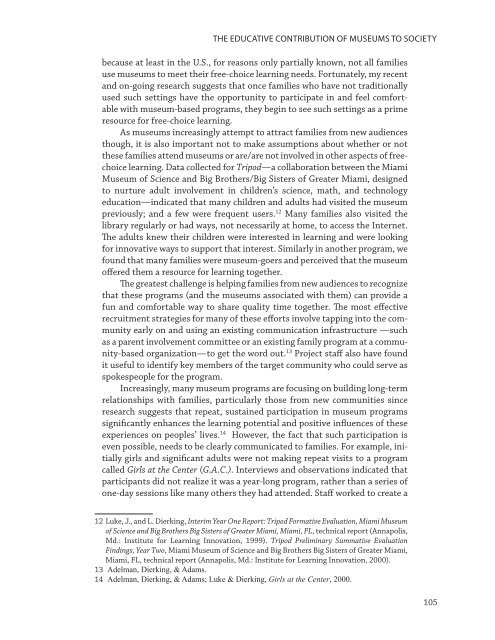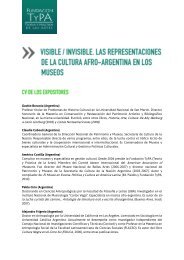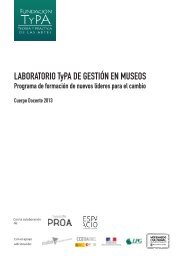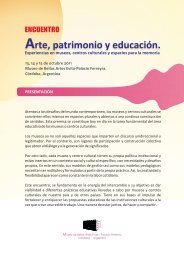La aportación educativa de Los museos a La ... - Fundación Typa
La aportación educativa de Los museos a La ... - Fundación Typa
La aportación educativa de Los museos a La ... - Fundación Typa
Create successful ePaper yourself
Turn your PDF publications into a flip-book with our unique Google optimized e-Paper software.
the educative contribution of museums to society<br />
because at least in the U.S., for reasons only partially known, not all families<br />
use museums to meet their free-choice learning needs. Fortunately, my recent<br />
and on-going research suggests that once families who have not traditionally<br />
used such settings have the opportunity to participate in and feel comfortable<br />
with museum-based programs, they begin to see such settings as a prime<br />
resource for free-choice learning.<br />
As museums increasingly attempt to attract families from new audiences<br />
though, it is also important not to make assumptions about whether or not<br />
these families attend museums or are/are not involved in other aspects of freechoice<br />
learning. Data collected for Tripod—a collaboration between the Miami<br />
Museum of Science and Big Brothers/Big Sisters of Greater Miami, <strong>de</strong>signed<br />
to nurture adult involvement in children’s science, math, and technology<br />
education—indicated that many children and adults had visited the museum<br />
previously; and a few were frequent users. 12 Many families also visited the<br />
library regularly or had ways, not necessarily at home, to access the Internet.<br />
The adults knew their children were interested in learning and were looking<br />
for innovative ways to support that interest. Similarly in another program, we<br />
found that many families were museum-goers and perceived that the museum<br />
offered them a resource for learning together.<br />
The greatest challenge is helping families from new audiences to recognize<br />
that these programs (and the museums associated with them) can provi<strong>de</strong> a<br />
fun and comfortable way to share quality time together. The most effective<br />
recruitment strategies for many of these efforts involve tapping into the community<br />
early on and using an existing communication infrastructure —such<br />
as a parent involvement committee or an existing family program at a community-based<br />
organization—to get the word out. 13 Project staff also have found<br />
it useful to i<strong>de</strong>ntify key members of the target community who could serve as<br />
spokespeople for the program.<br />
Increasingly, many museum programs are focusing on building long-term<br />
relationships with families, particularly those from new communities since<br />
research suggests that repeat, sustained participation in museum programs<br />
significantly enhances the learning potential and positive influences of these<br />
experiences on peoples’ lives. 14 However, the fact that such participation is<br />
even possible, needs to be clearly communicated to families. For example, initially<br />
girls and significant adults were not making repeat visits to a program<br />
called Girls at the Center (G.A.C.). Interviews and observations indicated that<br />
participants did not realize it was a year-long program, rather than a series of<br />
one-day sessions like many others they had atten<strong>de</strong>d. Staff worked to create a<br />
12 Luke, J., and L. Dierking, Interim Year One Report: Tripod Formative Evaluation, Miami Museum<br />
of Science and Big Brothers Big Sisters of Greater Miami, Miami, FL, technical report (Annapolis,<br />
Md.: Institute for Learning Innovation, 1999). Tripod Preliminary Summative Evaluation<br />
Findings, Year Two, Miami Museum of Science and Big Brothers Big Sisters of Greater Miami,<br />
Miami, FL, technical report (Annapolis, Md.: Institute for Learning Innovation, 2000).<br />
13 A<strong>de</strong>lman, Dierking, & Adams.<br />
14 A<strong>de</strong>lman, Dierking, & Adams; Luke & Dierking, Girls at the Center, 2000.<br />
105






